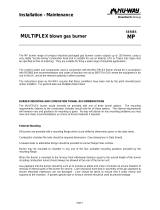2
Maintenance
16
Service Manual
WARNING
The combustion chamber lining in this
appliance contains ceramic fiber materials.
Ceramic fibers can transform into
cristobalite (crystalline silica) when exposed
to temperatures above 2192°F (1200°C)
dependent upon the length of exposure
time.*
The International Agency for Research on
Cancer (I.A.R.C.) has concluded, “Crystalline
silica inhaled in the form of quartz or
cristobalite from occupational sources is
carcinogenic to humans.”**
Testing has confirmed that the ceramic fibers
in this application do not reach 2192°F
(1200°C).
*Reference Dyson, D., Butler, M., Hughes, R.,
Fisher, R., and Hicks, G. The Devitrification
of Alumino-silicate Ceramic Fiber Materials
- The Kinetics of the Formation of Different
Crystalline Phases, Ann. Occup. Hyg. Vol. 41,
No. 55, 1997.
**Reference I.A.R.C. Monograph 68, June
1997.
Removal of combustion chamber lining or base
panels:
• Avoid breathing dust and contact with skin and eyes.
• Use NIOSH certified dust respirator (N95)
(http://www.cdc.gov/niosh/homepage.html).
• Lightly mist with water (only those areas being
handled) the combustion chamber lining or base
insulation to prevent airborne fibers.
• Remove combustion chamber lining or base insulation
from the pool heater and place it in a plastic bag for
disposal.
• Wash potentially contaminated clothes separately from
other clothing. Rinse clothes thoroughly.
• NIOSH stated First Aid:
Eye: Irrigate immediately.
Breathing: Fresh air.
The ceramic fiber material used in this
appliance is an irritant; when handling or
replacing the ceramic materials it is advisable
that the installer follow these safety guides.
NOTICE
1. Burner removal and cleaning procedure:
a) Turn off main power to the pool heater.
b) Turn off main manual gas shutoff to the pool heater.
c) Remove the front and top outer jacket panels.
d) Disconnect the gas supply from the gas valve
manifold assembly with a field supplied union
before the gas valve. Disconnect the union
between the gas valve and the manifold.
Figure 2-3_Gas Train Detached for Burner Removal
e) Remove mounting screws from the manifold
mounting brackets. Remove the manifold/orifice
assembly from the burners (FIG. 2-3).
f) Remove the mounting screws from each burner and
slide the burner out toward the front of the pool heater.
Use caution to prevent damage to burners, burner
gaskets, refractory, spark igniter, flame sense, or wiring.
g) Remove soot from burners with a stiff bristle brush.
Dirt may be removed from the burner ports by
rinsing the burner thoroughly with water. Drain and
dry burners before re-installing. Damaged burners
must be replaced.
A pool heater installed in a dust or dirt contaminated
atmosphere will require cleaning of the burners on a 3 to 6
month schedule or more often, based on severity of
contamination. Contaminants can be drawn in with the
combustion air. Non-combustible particulate matter such as
dust, dirt, concrete dust, or drywall dust can block burner ports
and cause non-warrantable failure. Use extreme care when
operating a pool heater during new construction. The burners
will probably require a thorough cleaning before the pool heater
is placed in service.























